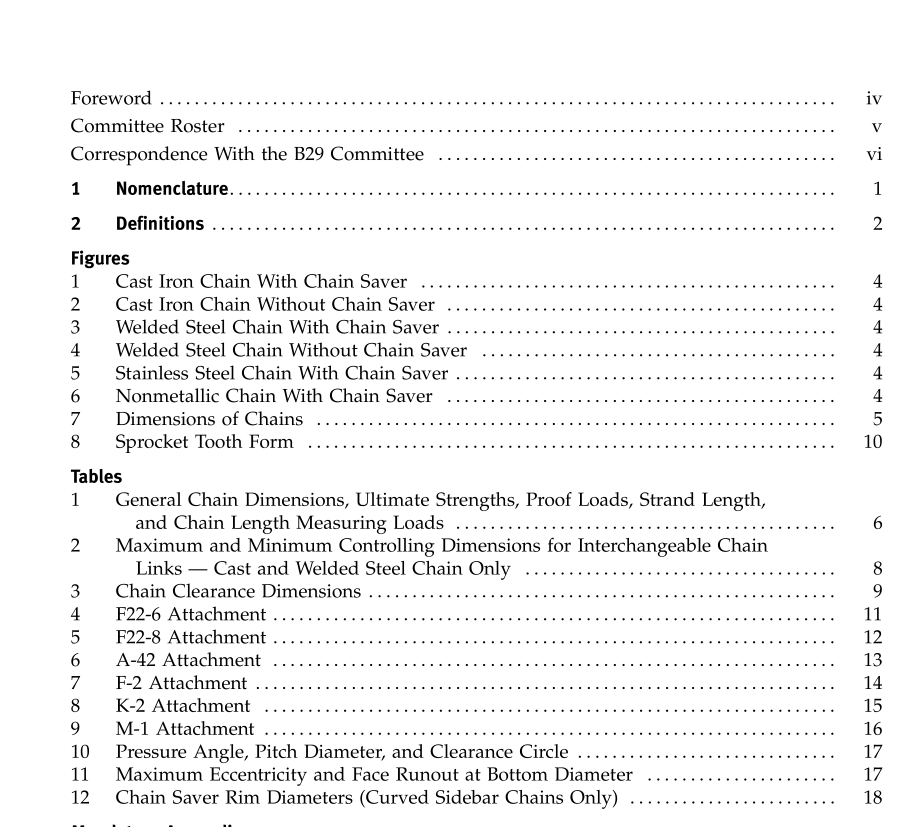ASME B29.21:2013 pdf free download 700 Class Chains, Attachments, and Sprocket Teeth for Water and Sewage Treatment Plants
1 NOMENCLATURE
1.1 Chain Types
• Cast iron chains
• Welded steel chains
• Stainless steel fabricated chains
• Nonmetallic (plastic) chains
1.1.1 Cast Iron Chains. Cast iron chains consist of a series of identical offset links having barrels to contact the sprocket teeth and pins that articulate in the barrels of links. Radius curves in the sidebars (chain savers), if present, operate on sprocket flanges known as chainsaver rims.
The purpose of the chain saver is to provide additional link support to reduce barrel O.D. wear. See Figs. 1 and 2. Pins are fixed in the sidebar pitch holes by mechanical locks to prevent rotation in the sidebar pitch holes. Pin cotters are stainless steel. Pin material is medium carbon steel or equivalent at 302 BHN minimum. Cast links, including attachments, are pearlitic malleable iron ASTM A220 Grade 60004 or equivalent at 179 BHN minimum.
1.1.2 Welded SteelChains. Welded steel chains con- sist of a series of identical offset links having barrels fixed to the sidebars by welds. Radius curves in the sidebars (chain savers), if present, operate on sprocket flanges known as chain-saver rims.
The purpose of the chain saver is to provide additional link support to reduce barrel O.D. wear. See Figs. 3 and 4. Pins are fixed in the sidebar pitch holes by press fits and mechanical locks to prevent rotation in the sidebar pitch holes. Pin cotters are stainless steel. Pin material is medium carbon steel or equivalent at 302 BHN minimum. Barrels are medium carbon steel or equivalent at 229 BHN minimum. Sidebars and attach- ments are medium carbon steel at 229 BHN minimum.
1.1.3 Stainless Steel Fabricated Chains. Stainless steel fabricated chains consist of a series of alternating inside and outside links having barrels to contact the sprocket teeth and pins that articulate in the barrels of links. Radius curves in the sidebars (chain savers) oper- ate on sprocket flanges known as chain-saver rims. The purpose of the chain saver is to provide additional link support to reduce barrel O.D. wear.
See Fig. 5. 1 Pins and bushings are fixed in the sidebar pitch holes by press fit and mechanical locks to prevent rotation in the sidebar pitch holes. Pin cotters are stainless steel. Pin, barrel, and sidebars are made from martensitic stainless steels with a minimum 11.5% chromium con- tent. Pins and barrels are heat treated for resistance to elongation and barrel wear.
1.1.4 Nonmetallic (Plastic) Chains. Nonmetallic (plastic) chains consist of a series of identical offset links having barrels to contact the sprocket teeth and pins that articulate in the barrels of links. Radius curves in the sidebars (chain savers) operate on sprocket flanges known as chain-saver rims. The purpose of the chain saver is to provide additional link support to reduce barrel O.D. wear. See Fig. 6. Pins are fixed in the sidebar pitch holes by press fit and/or mechanical locks to prevent rotation in the side- bar pitch holes. Pins and links are made from a variety ofplastic mate- rials and hardness levels, depending on the manufacturer.
The contour of the links and method of connecting links together are also unique to each manufacturer. No attempt will be made in this Standard to distinguish performance value ofany particular design. Rather, only the dimensions necessary for function on the standard 720S tooth form, attachment bolt hole pattern, proof load, and measuring load will be established.
1.2 Dimensions for Chain Links
1.2.1 Cast and Welded SteelChains. To assure inter- changeability of links and function over the standard tooth form as produced by different manufacturers of chain, standard maximum and minimum dimensions are adopted. They are not actual dimensions used in manufacturing, but limiting dimensions required to assure desired interchangeability. The following dimensional data can be found in this Standard for cast and welded steel chains:
(a) general chain dimensions, ultimate strengths, proof loads, strand length, and measuring loads (see Table 1 and Fig. 7)
(b) maximum and minimum controlling dimensions for interchangeability (see Table 2 and Fig. 7)
(c) the required maximum clearance dimensions (see Table 3 and Fig. 7)
ASME B29.21:2013 pdf free download
